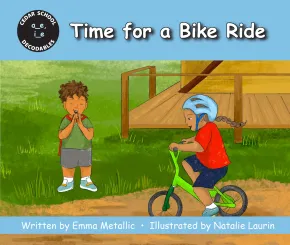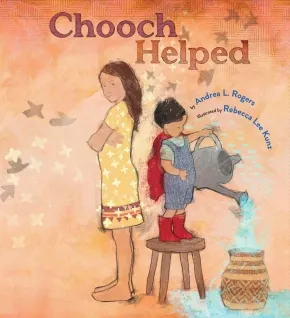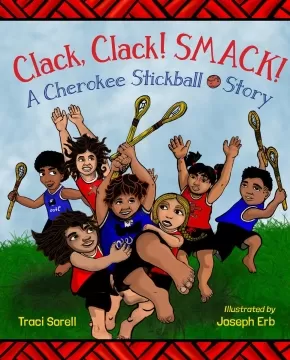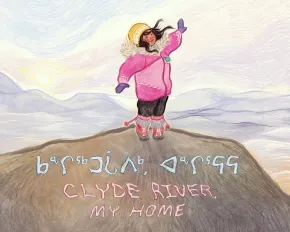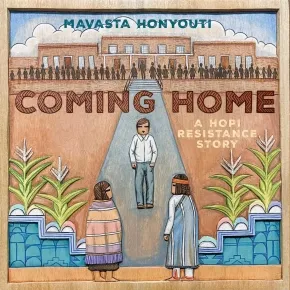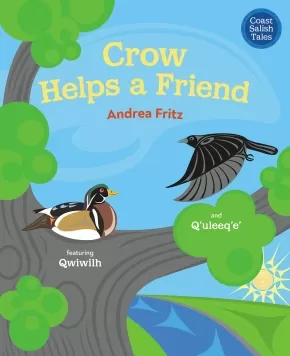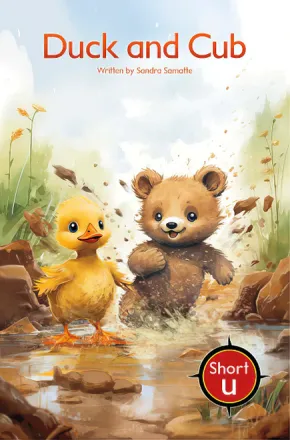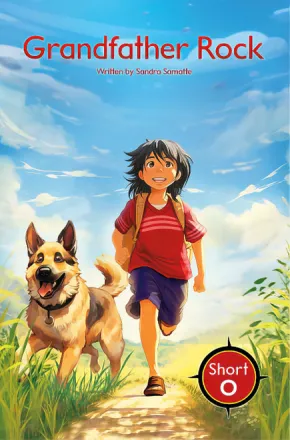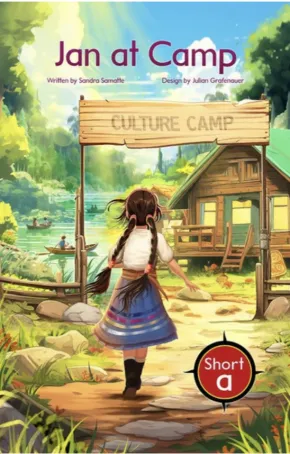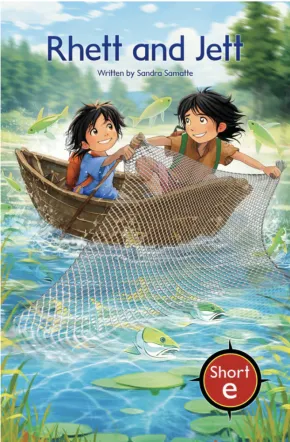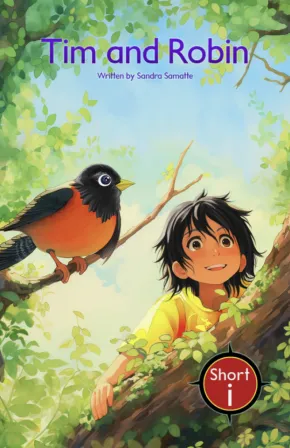
Language
76
-
90
of
422 Results;
Sort By
Go To
of 29
Cedar School Decodables: The Star World
 $7.99
$7.99

Artists:
Format:
Paperback
Text Content Territories:
Indigenous Canadian; First Nations; Mi'kmaq (Mi'gmaq); Listuguj Mi'gmaq First Nation;
Grade Levels: Kindergarten; 1;
ISBN / Barcode: 9781771746533
Synopsis:
Synopsis:
In this story, Jen shares a Mi’gmaw Creation Story. It explains how Mi’gmaq grew from the earth.
Mi’gmaq pass down knowledge and teachings through storytelling. Some stories are written with pictures instead of words. These pictures are called hieroglyphs.
Can you find the hieroglyph that means “lightning” in the book?
Educator Information
Recommended for ages 4-7, for use in kindergarten and Grade 1 classrooms.
Cedar School Decodables is divided into six sets, which increase in word count and complexity of sentence structure. The Star World is in Set 6 – R-Controlled Vowels, and reviews ar, or, and ore. Books in Set 6 have 110-125 words.
Readers should be familiar with the concepts included in Set 1 to Set 6:
- consonants
- beginning and end blends
- short, long, and r-controlled vowels
- digraphs
- suffixes and ending spelling patterns
- a /o/
- s – /s/ and /z/
- VC-CV, V/CV, VC/V, and compound words
- possessives
Series Information
Welcome to Cedar School! Join Liv, Tom, Gus, and Bell as they learn on the land and explore Mi’gmaw teachings with their teacher, Miss Sam, and the school’s Mi’gmaw Elder, Jen. With charming illustrations and simple storylines, this decodable series engages students as they practise their reading skills. Each book includes a pre-reading review of non-decodable words, and many of the books introduce special words related to Indigenous teachings. Talking Together prompts facilitate discussions led by the reading teacher.
Developed in partnership with Dyslexia Canada, Cedar School Decodables is a series of 20 decodable books for young readers. Designed for students who have previously learned short vowel and consonant sounds, additional phonic skills are developed progressively throughout the series.
The series will be accompanied by Cedar School Decodables Teacher’s Guide and a series of four picture books, which will be available at a later date.
Additional Information
16 pages | 6.5” x 5.5” | Paperback | ISBN: 9781771746533
Cedar School Decodables: Time for a Bike Ride
 $7.99
$7.99

Artists:
Format:
Paperback
Text Content Territories:
Indigenous Canadian; First Nations; Mi'kmaq (Mi'gmaq); Listuguj Mi'gmaq First Nation;
Grade Levels: Kindergarten; 1;
ISBN / Barcode: 9781771746441
Synopsis:
Synopsis:
In this story, Tom shares his bicycle with Gus, but Gus is nervous about riding it. Will he be brave?
Community is important to Mi’gmaq, which is why Mi’gmaq care for and look after each other. One of the ways they do this is by being a good friend.
Can you think of a time when a friend helped you?
Educator Information
Recommended for ages 4-7, for use in kindergarten and Grade 1 classrooms.
Cedar School Decodables is divided into six sets, which increase in word count and complexity of sentence structure. Time for a Bike Ride is in Set 3 – VCe, and reviews a_e and i_e. Books in Set 3 have 80-90 words.
Readers should be familiar with the concepts included in Set 1 to Set 3:
- consonants
- beginning and end blends
- short and long vowels
- digraphs
- a /o/
- s – /s/ and /z/
- -s and -es suffixes
- possessives
Series Information
Welcome to Cedar School! Join Liv, Tom, Gus, and Bell as they learn on the land and explore Mi’gmaw teachings with their teacher, Miss Sam, and the school’s Mi’gmaw Elder, Jen. With charming illustrations and simple storylines, this decodable series engages students as they practise their reading skills. Each book includes a pre-reading review of non-decodable words, and many of the books introduce special words related to Indigenous teachings. Talking Together prompts facilitate discussions led by the reading teacher.
Developed in partnership with Dyslexia Canada, Cedar School Decodables is a series of 20 decodable books for young readers. Designed for students who have previously learned short vowel and consonant sounds, additional phonic skills are developed progressively throughout the series.
The series will be accompanied by Cedar School Decodables Teacher’s Guide and a series of four picture books, which will be available at a later date.
Additional Information
16 pages | 6.5” x 5.5” | Paperback | ISBN: 9781771746441
Cedar School Decodables: We Smudge
 $7.99
$7.99

Artists:
Format:
Paperback
Text Content Territories:
Indigenous Canadian; First Nations; Mi'kmaq (Mi'gmaq); Listuguj Mi'gmaq First Nation;
Grade Levels: Kindergarten; 1;
ISBN / Barcode: 9781771746502
Synopsis:
Synopsis:
In this story, Gus and Tom are upset. Miss Sam helps them smudge to feel better.
Mi’gmaq burn sage and other traditional medicines to smudge. Smudging helps people let go of sadness and anger.
What do you do when you are feeling sad?
Educator Information
Recommended for ages 4-7, for use in kindergarten and Grade 1 classrooms.
Cedar School Decodables is divided into six sets, which increase in word count and complexity of sentence structure. We Smudge is in Set 5 – Ending Spelling Patterns, and reviews -tch and -dge. Books in Set 5 have 100-110 words.
Readers should be familiar with the concepts included in Set 1 to Set 5:
- consonants
- beginning and end blends
- short and long vowels
- digraphs
- suffixes and ending spelling patterns
- a /o/
- s – /s/ and /z/
- VC-CV, V/CV, VC/V, and compound words
This book is included in the Indigenous Books for Schools database from the Association of Book Publishers of BC. It is recommended for K to 1 classrooms for English Language Arts and Social Studies.
Series Information
Welcome to Cedar School! Join Liv, Tom, Gus, and Bell as they learn on the land and explore Mi’gmaw teachings with their teacher, Miss Sam, and the school’s Mi’gmaw Elder, Jen. With charming illustrations and simple storylines, this decodable series engages students as they practise their reading skills. Each book includes a pre-reading review of non-decodable words, and many of the books introduce special words related to Indigenous teachings. Talking Together prompts facilitate discussions led by the reading teacher.
Developed in partnership with Dyslexia Canada, Cedar School Decodables is a series of 20 decodable books for young readers. Designed for students who have previously learned short vowel and consonant sounds, additional phonic skills are developed progressively throughout the series.
The series will be accompanied by Cedar School Decodables Teacher’s Guide and a series of four picture books, which will be available at a later date.
Additional Information
16 pages | 6.5” x 5.5” | Paperback | ISBN: 9781771746502
Cedar School Decodables: What Track Is This?
$7.99
Artists:
Format:
Paperback
Text Content Territories:
Indigenous Canadian; First Nations; Mi'kmaq (Mi'gmaq); Listuguj Mi'gmaq First Nation;
Grade Levels: Kindergarten; 1;
ISBN / Barcode: 9781771746410
Synopsis:
Synopsis:
In this story, Miss Sam and the class are exploring the forest when they see an animal track on Cub Path! What animal made it?
Mi’gmaq use tracks to find animals in the forest. Mi’gmaq live in balance with the land and honour the animals that live on it.
Have you ever seen an animal track?
Educator Information
Recommended for ages 4-7, for use in kindergarten and Grade 1 classrooms.
Cedar School Decodables is divided into six sets, which increase in word count and complexity of sentence structure. What Track Is This? is in Set 2 – Digraphs, and reviews ck, sh, and th (voiced and unvoiced). Books in Set 2 have 60-80 words.
Readers should be familiar with the concepts included in Set 1 and Set 2:
- consonants
- beginning and end blends
- short vowels
- digraphs
- a /o/
- s – /s/ and /z/
- -s suffix
Series Information
Welcome to Cedar School! Join Liv, Tom, Gus, and Bell as they learn on the land and explore Mi’gmaw teachings with their teacher, Miss Sam, and the school’s Mi’gmaw Elder, Jen. With charming illustrations and simple storylines, this decodable series engages students as they practise their reading skills. Each book includes a pre-reading review of non-decodable words, and many of the books introduce special words related to Indigenous teachings. Talking Together prompts facilitate discussions led by the reading teacher.
Developed in partnership with Dyslexia Canada, Cedar School Decodables is a series of 20 decodable books for young readers. Designed for students who have previously learned short vowel and consonant sounds, additional phonic skills are developed progressively throughout the series.
The series will be accompanied by Cedar School Decodables Teacher’s Guide and a series of four picture books, which will be available at a later date.
Additional Information
16 pages | 6.5” x 5.5” | Paperback | ISBN: 9781771746410
Cedar School Decodables: Wild Strawberries
 $7.99
$7.99

Artists:
Format:
Paperback
Text Content Territories:
Indigenous Canadian; First Nations; Mi'kmaq (Mi'gmaq); Listuguj Mi'gmaq First Nation;
Grade Levels: Kindergarten; 1;
ISBN / Barcode: 9781771746519
Synopsis:
Synopsis:
In this story, Jen and the class pick wild strawberries. Back at school, Jen makes strawberry jam.
Wild strawberries grow throughout Mi’gmaw territory. Mi’gmaq harvest berries and other plants for food and medicine.
Have you ever gone berry picking?
Educator Information
Recommended for ages 4-7, for use in kindergarten and Grade 1 classrooms.
Cedar School Decodables is divided into six sets, which increase in word count and complexity of sentence structure. Wild Strawberries is in Set 5 – Ending Spelling Patterns, and reviews -ild, -old, -ind, -olt, and -ost. Books in Set 5 have 100-110 words.
Readers should be familiar with the concepts included in Set 1 to Set 5:
- consonants
- beginning and end blends
- short and long vowels
- digraphs
- suffixes and ending spelling patterns
- a /o/
- s – /s/ and /z/
- VC-CV, V/CV, VC/V, and compound words
Series Information
Welcome to Cedar School! Join Liv, Tom, Gus, and Bell as they learn on the land and explore Mi’gmaw teachings with their teacher, Miss Sam, and the school’s Mi’gmaw Elder, Jen. With charming illustrations and simple storylines, this decodable series engages students as they practise their reading skills. Each book includes a pre-reading review of non-decodable words, and many of the books introduce special words related to Indigenous teachings. Talking Together prompts facilitate discussions led by the reading teacher.
Developed in partnership with Dyslexia Canada, Cedar School Decodables is a series of 20 decodable books for young readers. Designed for students who have previously learned short vowel and consonant sounds, additional phonic skills are developed progressively throughout the series.
The series will be accompanied by Cedar School Decodables Teacher’s Guide and a series of four picture books, which will be available at a later date.
Additional Information
16 pages | 6.5” x 5.5” | Paperback | ISBN: 9781771746519
Chooch Helped
$29.99
Artists:
Format:
Hardcover
Text Content Territories:
Indigenous American; Native American; Cherokee;
ISBN / Barcode: 9781646144549
Synopsis:
Synopsis:
A Cherokee girl introduces her younger brother to their family's traditions — begrudgingly! — in this picture book written by Walter Award-winner Andrea L. Rogers and featuring gorgeous collage illustrations from debut artist Rebecca Lee Kunz.
Sissy’s younger brother, Chooch, isn’t a baby anymore. They just celebrated his second birthday, after all. But no matter what Chooch does — even if he’s messing something up! Which is basically all the time! — their parents say he’s just “helping.” Sissy feels that Chooch can get away with anything!
When Elisi paints a mural, Chooch helps. When Edutsi makes grape dumplings, Chooch helps. When Oginalii gigs for crawdads, Chooch helps. When Sissy tries to make a clay pot, Chooch helps . . .
“Hesdi!” Sissy yells. Quit it! And Chooch bursts into tears. What follows is a tender family moment that will resonate with anyone who has welcomed a new little one to the fold. Chooch Helped is a universal story of an older sibling learning to make space for a new child, told with grace by Andrea L. Rogers and stunning art from Rebecca Lee Kunz showing one Cherokee family practicing their cultural traditions.
Awards
- 2025 Randolph Caldecott Medal
Educator Information
Recommended for ages 4 to 8.
Additional Information
48 pages | 9.85" x 10.80" | Hardcover
Clack, Clack! Smack! A Cherokee Stickball Story
$21.99
Artists:
Format:
Hardcover
Text Content Territories:
Indigenous American; Native American; Cherokee; Cherokee Nation (Cherokee Nation of Oklahoma);
ISBN / Barcode: 9781623541934
Synopsis:
Synopsis:
Vann, a struggling stickball player, competes in a game on the Cherokee Nation. Can he help his team win? Written by award-winning Cherokee author Traci Sorell.
Vann loves playing his tribe’s stickball game, but he’s not as skilled as his teammates. Vann stumbles, and he tries and fails to score. How can he help his teammates win?
Exciting and fast-paced, Clack, Clack! Smack! reminds readers that sportsmanship and being a team player is just as important as being the star. Back matter explains the origins of Cherokee stickball.
Reviews
"Two Cherokee teams play a game of stickball in Tahlequah, Oklahoma. Vann feels insecure about having missed a key shot in last week’s match. “Stickball requires speed,” after all, and his “towering body” won’t cooperate. As Vann and his team, the Eagles, take to the field against the Redhawks, they “zip,” “chase,” and “rush” for the ball, their wooden sticks clashing with a “CLACK, CLACK!” Coach gives the team a pep talk in Tsalagi, the Cherokee language. He reminds them of gadugi, the importance of working together. As the players return to the field to finish the game, Vann’s best friend, Jesse, gives him an encouraging smile. The game is now tied. Can Vann and his team win? Sorell and Erb, both members of the Cherokee Nation, deliver an uplifting story of team spirit and collaboration; the emphasis is on group triumphs rather than individual victories. Writing in terse, alliterative prose—“a tackle, a twist, and a wrong turn”—Sorell skillfully builds tension as she choreographs this action-packed game. Erb’s thick-lined cartoon illustrations have a pleasing solidity; they capture the chaos and drama of the game and depict players with a range of brown skin tones. The story features frequent Tsalagi words and phrases. Backmatter stresses the importance of keeping the Cherokee language alive and explains the significance of stickball, which traditionally was used to settle conflicts. Stand and cheer for this fast-paced tale of sportsmanship and community." —Kirkus Reviews
Educator Information
Recommended for ages 4 to 7.
Additional Information
32 pages | 8.38" x 10.31" | Hardcover
Clyde River, My Home
$16.95
Artists:
Format:
Paperback
Grade Levels: Preschool; Kindergarten;
ISBN / Barcode: 9781774507711
Synopsis:
Synopsis:
Clyde River, Nunavut is a great place to live! In this bilingual picture book, Louise tells us about all the things she and her family like to do. With the annual fishing derby in the spring and Hamlet Day in the summer, there are lots of fun things to do throughout the year. Winter brings plenty of time to connect with people in the community and support each other. Learn about the different activities people do in each season in Clyde River, its landmarks, and the amazing wildlife you can see there, like bowhead whales.
Reviews
"This bilingual book, written in English and Inuktitut, follows young Louise as she shares her deep connection to Clyde River, Nunavut, her childhood home. Through vivid descriptions of community sites and seasonal traditions, Louise offers readers a glimpse into Inuit life, blending modern and Traditional practices. Site names are given in both languages to celebrate cultural preservation and identity. As Louise’s story reflects the author’s own roots, the narrative feels intimate and authentic. The book encourages understanding of Canada’s diverse cultures and fosters appreciation of Inuit heritage and storytelling." - Anika L., Middle School Teacher, Indigenous Books for Schools
Educator & Series Information
Recommended for ages 3 to 5.
Dual-Language: English & Inuktitut
This book is part of the Community Connections series.
This book is included in the Indigenous Books for Schools database from the Association of Book Publishers of BC. It is recommended for Grades 2 to 5 for English Language Arts and Social Studies.
Additional Information
27 pages | 8.00" x 10.00" | Paperback
Coming Home: A Hopi Resistance Story
$28.99
Artists:
Format:
Hardcover
ISBN / Barcode: 9781646144570
Synopsis:
Synopsis:
From master Hopi woodcarver Mavasta Honyouti, the story of his grandfather’s experience at a residential boarding school and how he returned home to pass their traditions down to future generations.
When Mavasta Honyouti was a boy he would go with his grandfather to their cornfield, watching him nurture every plant. During breaks, his grandfather would take out a piece of paako root and use his pocketknife to whittle away. He made beautiful carvings that Mavasta would later learn to do himself.
But Mavasta would often wonder: what was his kwa’a like when he was a boy? And one day, he heard the story.
Mavasta’s grandfather, like many Native American children across the country in the late 19th and early 20th century, was forced to leave his Hopi reservation as a child and go to a residential boarding school far away. There, the government cut his hair, punished him for speaking his native language, and gave him a new name. But Mavasta's grandfather never forgot who he was – or where he came from – and he tried to escape again and again. Finally, he made it back to their reservation.
In later years, Mavasta’s kwa’a chose a simple life, taking great care of his family just like he took great care of his plants. His son and later his grandson became acclaimed Hopi katsina woodcarvers, just like him. Coming Home: A Hopi Resistance Story is a deeply personal book – written in both English and Hopi – that features sixteen stunning original painted wood carvings. It is an unforgettable testament to one man rising above a painful piece of history to keep the light of his family and culture alive.
Educator Information
Recommended for ages 4 to 8.
Dual-language: English and Hopi.
Additional Information
48 pages | 9.00" x 9.20" | Hardcover
Crow Helps a Friend
$21.95
Artists:
Format:
Hardcover
Text Content Territories:
Indigenous Canadian; First Nations; Salish; Coast Salish; Lyackson ;
ISBN / Barcode: 9781459836242
Synopsis:
Synopsis:
Mistakes can be an opportunity for growth.
Indigenous artist and storyteller Andrea Fritz tells the tale of a wood duck and a crow who turn a mistake into an opportunity for friendship and growth.
Qwiwilh the wood duck is preparing to nest in his favorite tree when Q'uleeq'e' the crow invites him to play in the tall branches. They jump higher and higher up the tree until they accidentally break the branches and come crashing down into the stream below. After a daring rescue, Qwiwilh sadly realizes his nesting spot is gone, and Q'uleeq'e' decides to make things right for her new friend.
In this original story set in Coast Salish Traditional Territory, author and artist Andrea Fritz uses Indigenous storytelling techniques and art to share the culture and language of the Hul’q’umi’num’-speaking Peoples. This is the second book in the Coast Salish Tales, following Otter Doesn't Know.
Educator & Series Information
Recommended for ages 6 to 8.
This is the second book in the Coast Salish Tales series, following Otter Doesn't Know.
Recommended in the Indigenous Books for Schools catalogue as a valuable resource for English Language Arts and Art in K to Grade 3.
Themes: Animals, Art, Community, Connectedness to Nature, Respect, Language, Relationships, Traditional Knowledge
Additional Information
32 pages | 8.75" x 10.75" | Hardcover
Drumbeat Decodable Book Collection: Duck and Cub
$9.99
Artists:
Format:
Paperback
Text Content Territories:
Indigenous Canadian;
ISBN / Barcode: 9781990297861
Synopsis:
Synopsis:
Read along with Duck and Cub and learn the Short 'u' Vowel.
Educator & Series Information
Recommended for K-2.
This book is part of the Drumbeat Decodable Book Collection Series 1. It is recommended for K-2 for learning short vowels a, e, i, o, and u. Teach children short vowels in the context of cvc (consonant-vowel-consonant) words in the high-frequency and fun Indigenous Decodable Books. Books in this series provide the systematic practice children need to become phonics-wise readers. These stories bring Indigenous content that is much needed in any phonics program. Each book contains a word list, high-frequency words, story words, short vowel words, and two fun activities for extended learning.
Additional Information
Paperback
Drumbeat Decodable Book Collection: Grandfather Rock
$9.99
Artists:
Format:
Paperback
Text Content Territories:
Indigenous Canadian;
ISBN / Barcode: 9781990297885
Synopsis:
Synopsis:
Read Grandfather Rock and learn the Short ‘o’ Vowel.
Educator & Series Information
Recommended for K-2.
This book is part of the Drumbeat Decodable Book Collection Series 1. It is recommended for K-2 for learning short vowels a, e, i, o, and u. Teach children short vowels in the context of cvc (consonant-vowel-consonant) words in the high-frequency and fun Indigenous Decodable Books. Books in this series provide the systematic practice children need to become phonics-wise readers. These stories bring Indigenous content that is much needed in any phonics program. Each book contains a word list, high-frequency words, story words, short vowel words, and two fun activities for extended learning.
Additional Information
Paperback
Drumbeat Decodable Book Collection: Jan at Camp
$9.99
Artists:
Format:
Paperback
Text Content Territories:
Indigenous Canadian;
ISBN / Barcode: 9781990297847
Synopsis:
Synopsis:
In this decodable book, read along with Jan and learn the Short 'a' Vowel.
Educator & Series Information
Recommended for K-2.
This book is part of the Drumbeat Decodable Book Collection Series 1. It is recommended for K-2 for learning short vowels a, e, i, o, and u. Teach children short vowels in the context of cvc (consonant-vowel-consonant) words in the high-frequency and fun Indigenous Decodable Books. Books in this series provide the systematic practice children need to become phonics-wise readers. These stories bring Indigenous content that is much needed in any phonics program. Each book contains a word list, high-frequency words, story words, short vowel words, and two fun activities for extended learning.
Additional Information
Paperback
Drumbeat Decodable Book Collection: Rhett and Jett
$9.99
Artists:
Format:
Paperback
Text Content Territories:
Indigenous Canadian;
ISBN / Barcode: 9781990297878
Synopsis:
Synopsis:
Read along with Rhett and Jett and learn the Short ‘e’ Vowel.
Educator & Series Information
Recommended for K-2.
This book is part of the Drumbeat Decodable Book Collection Series 1. It is recommended for K-2 for learning short vowels a, e, i, o, and u. Teach children short vowels in the context of cvc (consonant-vowel-consonant) words in the high-frequency and fun Indigenous Decodable Books. Books in this series provide the systematic practice children need to become phonics-wise readers. These stories bring Indigenous content that is much needed in any phonics program. Each book contains a word list, high-frequency words, story words, short vowel words, and two fun activities for extended learning.
Additional Information
Paperback
Drumbeat Decodable Book Collection: Tim and Robin
$9.99
Artists:
Format:
Paperback
Text Content Territories:
Indigenous Canadian;
ISBN / Barcode: 9781990297854
Synopsis:
Synopsis:
Read along with Tim and Robin and learn the Short ‘i’ Vowel.
Educator & Series Information
Recommended for K-2.
This book is part of the Drumbeat Decodable Book Collection Series 1. It is recommended for K-2 for learning short vowels a, e, i, o, and u. Teach children short vowels in the context of cvc (consonant-vowel-consonant) words in the high-frequency and fun Indigenous Decodable Books. Books in this series provide the systematic practice children need to become phonics-wise readers. These stories bring Indigenous content that is much needed in any phonics program. Each book contains a word list, high-frequency words, story words, short vowel words, and two fun activities for extended learning.
Additional Information
Paperback
Sort By
Go To
of 29




